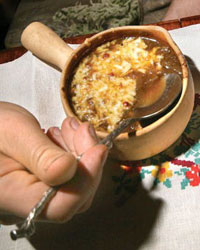|
| ||
| Soup without tears
by Ari LeVaux French onion soup was the last meal Julia Child ate before she died. Perhaps it was a premonition, the earthy flavors of concentrated onion-root wafting up from the underworld and foreshadowing her descent. And while it generally won’t kill you, a good batch of French onion soup can jerk a lot of tears before it takes you to heaven. Legend has it that King Louis XV invented French onion soup after arriving at a hunting cabin and finding only onions, wine and butter in the cupboard. But the reality is that the average farmer’s larder was stocked with just these ingredients on winter days. Like many French recipes Child helped popularize, French onion soup is a simple dish, essentially a fancy version of a common peasant food, and made with inexpensive and locally available ingredients. “I didn’t have to go to the store for anything,” said my friend El Camino, who made French onion soup the other day. “It worked out great.” The price tag makes homemade French onion soup a good option when money is tight, and its rich, warming and concentrated flavor makes it good wintertime food. Which suggests, all things considered, that now might be a good time for some French onion soup. El Camino had recently traded with a farmer friend of his for a big batch of organic onions. He packed away the good ones for storage, and removed the less-than-rock-hard specimens. He ended up with 20 pounds of soft onions, 14 pounds of which were yellow onions, which he decided to preserve as frozen portions of French onion soup. “I ran out of tears,” he says, of his adventure cutting those onions.The secret to good French onion soup is to slowly oven-roast the onions in butter, El Camino says. This gently concentrates the sweetness of the onions without burning them. Doing so in the oven, and not on the stovetop, slows the process and provides a cushion against overbrowning, as you don’t have to watch it like a hawk as you do when browning onions on a stovetop. “I tasted the onions after a few hours, and they were sweet, like fruit,” El Camino said. “I couldn’t believe it. I kind of wish I’d served it like that, but I kept going ’til it was mahogany brown, like it says in Cooks Illustrated.” He served his soup topped with a slice of bread and grated Gruyere on top, in personal-sized clay pots he’d scored at Goodwill. Fully loaded and dressed, the pots were broiled until the cheese melted. When I tasted his soup, the bottom dropped out of my mouth. I was tasting the sweet fragrance of the earth, first concentrated into the form of onion bulbs, then concentrated again into the brown broth in my mouth. I enjoyed the finishing presentation of bread and cheese, but at the same time they were a bit of a distraction. The oniony broth so was the soul in that bowl, and that’s where I really wanted to focus. The recipe El Camino used was a modified version of a Cooks Illustrated recipe that, as is common with Cooks Illustrated, is detailed to the point of micro-management. You can find the Cooks Illustrated recipe at cookography.com. But I’m partial to a Nigel Slater recipe that’s very similar at heart – right down to caramelizing the onions in the oven rather than on the stovetop – but reads more conversationally, and less like a laboratory protocol, than the Cooks Illustrated version. Best of all, because the onions are cut in halves, instead of laboriously sliced or chopped, you won’t run out of tears like El Camino did. Thus, the recipe, which is called “Onion Soup without Tears,” minimizes the cook’s exposure to onion fumes. The only thing I would add to Slater’s recipe is to back the temperature down to 250-275 once the oven is pre-heated, and slowly caramelize the onions at that temperature – minimizing the risk of burning them if you space out. Here’s the recipe, as printed in The Kitchen Diaries (Gotham, 2005). I’ve inserted ingredient quantities in brackets. “Set the oven to 400 degrees. Peel the onions [four medium-sized, yellow] and cut them in half from tip to root, then lay them in a roasting tin and add the butter [2 tablespoons], salt and some pepper. Roast until they are tender and soft, and toasted dark brown here and there. You might have to turn them now and again. “Cut the onions into thick segments. Put them in a saucepan with the wine [one glass, white] and bring to a boil. Let the wine bubble until it almost disappears (you just want the flavor, not the alcohol), then pour in the stock [six cups, beef or vegetable]. Bring to the boil and simmer for about 20 minutes. “Just before you want to serve the soup, make the cheese croutes. Cut the loaf [French baguette] into thin slices and toast lightly on one side under a hot grill (broiler). Turn them over and sprinkle with the grated Gruyere. Get the soup hot, ladle it into bowls and float the cheese croutes on top. Place the bowls under a hot grill (broiler) and leave until the cheese melts. Eat immediately, whilst the cheese is still stringy and molten.” El Camino added thyme to his soup as well, as per Cooks Illustrated, and I’ll vouch for that being a good thing. Indeed, there are many variations on the simple equation of wine, onions and butter. Which method you choose depends on your tastes, your schedule, your attention to detail and how attached you are to your tears. •
|


